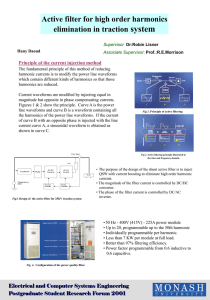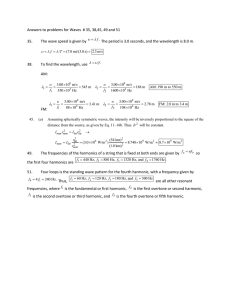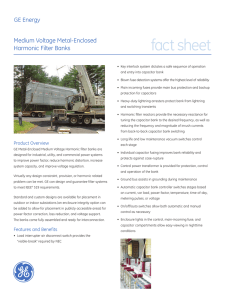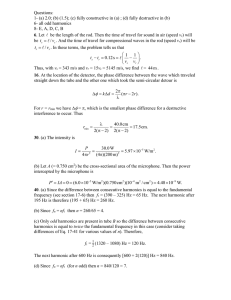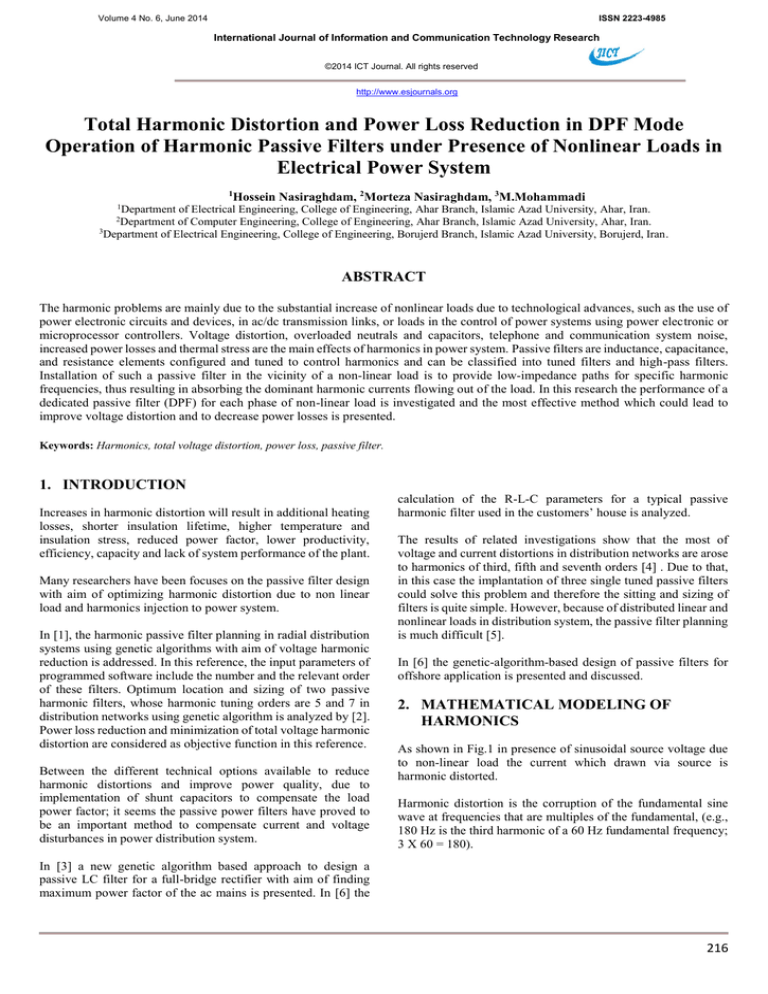
Volume 4 No. 6, June 2014
ISSN 2223-4985
International Journal of Information and Communication Technology Research
©2014 ICT Journal. All rights reserved
http://www.esjournals.org
Total Harmonic Distortion and Power Loss Reduction in DPF Mode
Operation of Harmonic Passive Filters under Presence of Nonlinear Loads in
Electrical Power System
1
Hossein Nasiraghdam, 2Morteza Nasiraghdam, 3M.Mohammadi
1Department
of Electrical Engineering, College of Engineering, Ahar Branch, Islamic Azad University, Ahar, Iran.
of Computer Engineering, College of Engineering, Ahar Branch, Islamic Azad University, Ahar, Iran.
3Department of Electrical Engineering, College of Engineering, Borujerd Branch, Islamic Azad University, Borujerd, Iran.
2Department
ABSTRACT
The harmonic problems are mainly due to the substantial increase of nonlinear loads due to technological advances, such as the use of
power electronic circuits and devices, in ac/dc transmission links, or loads in the control of power systems using power electronic or
microprocessor controllers. Voltage distortion, overloaded neutrals and capacitors, telephone and communication system noise,
increased power losses and thermal stress are the main effects of harmonics in power system. Passive filters are inductance, capacitance,
and resistance elements configured and tuned to control harmonics and can be classified into tuned filters and high-pass filters.
Installation of such a passive filter in the vicinity of a non-linear load is to provide low-impedance paths for specific harmonic
frequencies, thus resulting in absorbing the dominant harmonic currents flowing out of the load. In this research the performance of a
dedicated passive filter (DPF) for each phase of non-linear load is investigated and the most effective method which could lead to
improve voltage distortion and to decrease power losses is presented.
Keywords: Harmonics, total voltage distortion, power loss, passive filter.
1. INTRODUCTION
Increases in harmonic distortion will result in additional heating
losses, shorter insulation lifetime, higher temperature and
insulation stress, reduced power factor, lower productivity,
efficiency, capacity and lack of system performance of the plant.
Many researchers have been focuses on the passive filter design
with aim of optimizing harmonic distortion due to non linear
load and harmonics injection to power system.
In [1], the harmonic passive filter planning in radial distribution
systems using genetic algorithms with aim of voltage harmonic
reduction is addressed. In this reference, the input parameters of
programmed software include the number and the relevant order
of these filters. Optimum location and sizing of two passive
harmonic filters, whose harmonic tuning orders are 5 and 7 in
distribution networks using genetic algorithm is analyzed by [2].
Power loss reduction and minimization of total voltage harmonic
distortion are considered as objective function in this reference.
Between the different technical options available to reduce
harmonic distortions and improve power quality, due to
implementation of shunt capacitors to compensate the load
power factor; it seems the passive power filters have proved to
be an important method to compensate current and voltage
disturbances in power distribution system.
calculation of the R-L-C parameters for a typical passive
harmonic filter used in the customers’ house is analyzed.
The results of related investigations show that the most of
voltage and current distortions in distribution networks are arose
to harmonics of third, fifth and seventh orders [4] . Due to that,
in this case the implantation of three single tuned passive filters
could solve this problem and therefore the sitting and sizing of
filters is quite simple. However, because of distributed linear and
nonlinear loads in distribution system, the passive filter planning
is much difficult [5].
In [6] the genetic-algorithm-based design of passive filters for
offshore application is presented and discussed.
2. MATHEMATICAL MODELING OF
HARMONICS
As shown in Fig.1 in presence of sinusoidal source voltage due
to non-linear load the current which drawn via source is
harmonic distorted.
Harmonic distortion is the corruption of the fundamental sine
wave at frequencies that are multiples of the fundamental, (e.g.,
180 Hz is the third harmonic of a 60 Hz fundamental frequency;
3 X 60 = 180).
In [3] a new genetic algorithm based approach to design a
passive LC filter for a full-bridge rectifier with aim of finding
maximum power factor of the ac mains is presented. In [6] the
216
Volume 4 No. 6, June 2014
ISSN 2223-4985
International Journal of Information and Communication Technology Research
©2014 ICT Journal. All rights reserved
http://www.esjournals.org
Pavg Vk rms I k rms cos k k
(6)
k 1
P1avg P2 avg P3avg ....
Where, we see that each harmonic makes a contribution, plus or
minus, to the average power.
A frequently-used measure of harmonic levels is total harmonic
distortion (or distortion factor), which is the ratio of the rms
value of the harmonics (above fundamental) to the rms value of
the fundamental as follows:
Fig.1.Harmonic distorted current wave
Vk2rms
THD V
Total harmonic distortion, or THD, based on the IEEE definition,
is the summation of all harmonic components of the voltage or
current waveform M i compared against the fundamental
THD
i 2
THD I
Now, consider non-sinusoidal situations, where network
voltages and currents contain harmonics. While some harmonics
are caused by system nonlinearities such as transformer
saturation, most harmonics are produced by power electronic
loads such as adjustable-speed drives and diode-bridge rectifiers.
The significant harmonics (above the fundamental, i.e., the first
harmonic) are usually the 3rd, 5th, and 7th multiples of
fundamental component i.e. 50 Hz, so that the frequencies of
interest in harmonics studies are in the low-audible range.
Vrms V1 rms 1 (THD V / 100 ) 2
(9)
I rms I1 rms 1 (THD I / 100 ) 2
(10)
Now, with substituting mentioned equations it yields the
following exact form of true power factor, valid for both
sinusoidal and non-sinusoidal situations:
PFtrue
(11)
Pavg
V1 rms I 1 rms 1 (THDV / 100) 2 1 (THDI / 100) 2
A useful simplification can be made by expressing (2) as a
product of two components,
(3)
PFtrue
Vrms
I rms
k 1
(4)
Vk2rms
Pavg
(5)
1.
k 1
2.
The average power is given by:
(12)
V1 rms I 1 rms
1
1 (THDV / 100)
2
1 (THDI / 100) 2
And by making the following two assumptions:
I 2k rms
100 %
I1 rms
Whose rms values can be shown to be:
(8)
(2)
k 1
(7)
Obviously, if no harmonics are present, then the THDs are zero.
If we substitute equations, we find that:
The end result is a percentage comparing the harmonic
components to the fundamental component of a signal. The
higher the percentage, the more distortion that is present on the
mains signal.
i( t ) I k sin(0 t k )
k 2
(1)
M1
k 1
V1 rms
I 2k rms
2
i
v( t ) Vk sin( 0 t k )
100 %
component of the voltage or current M 1 [7]:
M
k 2
In most cases, the contributions of harmonics above the
fundamental to average power in (6) are small, so that
Pavg ≈ P1avg.
Since THDV is usually less than 10%, then from (9) we
see that Vrms ≈ V1rms.
217
Volume 4 No. 6, June 2014
ISSN 2223-4985
International Journal of Information and Communication Technology Research
©2014 ICT Journal. All rights reserved
http://www.esjournals.org
Incorporating these two assumptions into (12) yields the
following approximate form for true power factor:
PFtrue
P1 avg
V1 rms I 1 rms
1
1 (THDI / 100) 2
(13)
1
DPF
1 (THDI / 100) 2
1
1
1
Zh
j
jn s C h
R n jn s L n
1
(15)
For harmonics whose frequency is larger than n-th order, high
pass filter is adopted as a low-impedance. It makes these
harmonic currents flowing into the high pass filter.
The target of PPF’s optimal design is to meet requirements and
to maximize overall efficiency. Optimal parameters shall meet
the following requirements:
3. PPF PRINCIPLE
Passive power filter is an appropriate combination of capacitor,
inductor and resistor. It has been divided into single-tuned filter,
high pass filter and double-tuned filter, and so on. Because
double-tuned filter is complex in structure and difficult to tune,
PPF usually consists of several single-tuned filters and a high
pass filter in practice, which is showed in Fig.1. Here, SPF k and
SPFm express single-tuned filters. HPF is a high pass filter.
• Lower total harmonics distortion of voltage or current;
• Lower initial investment costs;
• Higher power factor, whereas reactive power can’t be
overcompensation;
• No series or parallel resonant with impedance of the system
results in the amplification of harmonic;
• The design should ensure that in the normal fluctuation of
frequency, the filter can also meet the technology
requirements.
4. THE EFFECTS OF HARMONICS ON
SYSTEM
Fig.1. Typical structure of PPF
Suppose n is the resonant frequency. The impedance of
each single-tuned filter Zn is shown as follows.
1
Z n R n j ns L n
ns C n
(14)
Where s is the fundamental angle frequency of power system;
Rn , Ln , and Cn are the resistor, inductor, and capacitor in the
filter, respectively. We know that the resonance will occur when
n s L n
1
n s C n
.
When above condition is satisfied, the filter has the minimal
impedance, which is equal to Rn. Because Rn is very small, the
n-th harmonic current will mainly flow into the filter and seldom
flow into the power system. For other harmonic currents, the
impedance is much bigger than Rn. So other harmonic currents
seldom flow into this filter.
As a result, once the order of the harmonic frequency equals to
the resonant frequency of the filer, the harmonic current will
flow into this filter. Therefore, this harmonic current will be
eliminated from the power system.
The high pass filter has lots of forms, in which the 2-order high
pass filter is most commonly used. The impedance of 2-order
high pass filter Zh is:
Harmonics increase the equipment losses and thus the thermal
stress. The triple harmonics result in the neutral carrying a
current which might equal or exceed the phase currents even if
the loads are balanced. This dictates the derating or over sizing
of neutral wires. Moreover, harmonics caused resonance might
damage the equipment. Harmonics further interfere with
protective relays, metering devices, control and communication
circuits, and customer electronic equipment. Sensitive
equipment would experience mal-operation or component
failure. Waveform distortions can drastically alter the shape of
the sinusoid. However, no matter the level of complexity of the
fundamental wave, it is actually just a composite of multiple
waveforms called harmonics.
Failure, tripping or overheating of capacitors, filters and related
equipment, abnormally high noise levels in capacitors, cables,
transformers and lightning equipment, overheating of
transformers, cables, switchgear, conductors, an abnormally
high rate of failures of thyristors and converter equipment,
frequent failures of capacitors in lighting equipment or tripping
of associated low voltage circuit breakers, nuisance failures of
fuses, nuisance tripping of protection relays, in particular
sensitive earth fault relays or earth leakage relays, apparent
errors in electronic power transducers, apparent inconsistencies
in metering equipment. interference with computer equipment
and an abnormally high cable failure rate or an increase in cable
failures are some of main effects of harmonics in power systems.
Each element of the power system must be examined for its
sensitivity to harmonics as a basis for recommendations on the
allowable levels. The main effects of voltage and current
harmonics within the power system are [8-10]:
Transformer secondary voltage distortion
218
Volume 4 No. 6, June 2014
ISSN 2223-4985
International Journal of Information and Communication Technology Research
©2014 ICT Journal. All rights reserved
http://www.esjournals.org
Overloaded neutrals and capacitors
Telephone and communication system noise
Increased power losses and thermal stress
Elements
AC mains
Parameter Value
Load impedance
VFD1 : R L 15 C L 300 F
230 V, 50 Hz
VFD2 : R L 15 C L 300 F
VFD3 : R L 10 C L 300 F
5. MATLAB/SIMULINK based simulation
Transformer equivalent
The simulation model of test system in order to analysis the
performance of passive filter under DFP states is presented in
Fig.2.
The power system elements, including power source,
interconnecting cable, transformer, variable frequency drives
(VFDs) as non-linear load which is considered as harmonic
source, and passive filter bank, is modeled in MATLAB.
The non-linear load has been modeled with a diode rectifier with
a smoothing capacitance of 300 F and an ac drive as equivalent
resistance which represents the real power consumed by the load.
This equivalent resistance corresponds to a 10.4-kW drive.
The parameters of system including cable impedance,
transformer equivalent parameters, passive filter parameters,
main source and non-linear load are listed in Table 1.
Passive filter
0.15 ,
6 mH
L 5 10.34 mH C 5 36.34 F
L 7 10.34 mH C 7 18.86 F
Cable impedance
0.6 / km,0.3mH / Km,3F / km
Table 2 clearly shows that the application of passive filters
reduces the net rms source current from 73.3 to 72.8A for
multiple DPFs for each VFD. It can be clearly seen that the
THDs of current and voltage have been improved further with
DPF performance of passive filters.
Table 2- Simulation results for DPF application of
PPF
Current/Voltage
Load current
Source current with DPF
Voltage at PCC
Voltage at PCC with DPF
RMS value
73.29 A
72.88 A
313.92 V
328.57 V
THD%
38.13
1.27
27.52
6.93
Table 1- System parameters
Fig.2. Matlab/Simulink developed model of the test system including of power system and VFD loads for passive filter in DPF state
219
Volume 4 No. 6, June 2014
ISSN 2223-4985
International Journal of Information and Communication Technology Research
©2014 ICT Journal. All rights reserved
http://www.esjournals.org
In fig.3 the voltage at PCC without passive filter is shown.
Fig.4 shows the source and load current without passive filter.
In fig.7 the source and load current with passive filter under DPF
state is shown.
Fig.3.Voltage at PCC without passive filter
Fig.7.Source and load current with passive filter under DPF state
6. CONCLUSION
Fig.4.Source and load current without passive filter
In fig.5 the non-linear phase a, b, c currents without passive filter
is presented.
Fig.6 shows the voltage at PCC with passive filter under DPF
state.
In this research the performance of a dedicated passive filter
(DPF) for each phase of non-linear load is investigated and the
most effective method which could lead to improve voltage
distortion and to decrease power losses is presented. Increases in
harmonic distortion will result in additional heating losses,
shorter insulation lifetime, higher temperature and insulation
stress, reduced power factor, lower productivity, efficiency,
capacity and lack of system performance of the plant. The good
performance of harmonic passive filters under dedicated passive
filter mode in this research showed that in practical application
in power electrical industry, passive filters can help to system
and compensate the harmonics arisen due to non linear load in
power system.
REFERENCES
[1] J. L. Afonso, C. Couto, J. S. Martins, “Active Filters with
Control Based on the p-q Theory”, IEEE Industrial
Electronics Society Newsletter, vol. 47, nº 3, Set. 2000, pp.
5-10.
[2] M. Erhan Balci, M. Hakan Hocaoglu, Effects of Source
Voltage Harmonics on Power Factor Compensation in AC
Chopper Circuits, Electrical Power Quality and Utilization,
Journal Vol. XIV, No. 1, 2008.
Fig.5.Non-linear phase a, b, c currents without passive filter
[3] Sueker K.H., Hummel S.D., and Argent R.D., Power factor
correction and harmonic mitigation in a thyristor controlled
glass melter, IEEE Transactions on Industry Applications
1989, 6: 972–975.
[4] W. Mack Grady and et.al, Harmonics and how they relate to
power factor, Proc. of the EPRI Power Quality Issues &
Opportunities Conference (PQA’93), San Diego, CA,
November 1993.
Fig.6.Voltage at PCC with passive filter under DPF state
[5] Prachi Godbole, Effect of harmonics on active power flow
and apparent power in the power system, IOSR Journal of
220
Volume 4 No. 6, June 2014
ISSN 2223-4985
International Journal of Information and Communication Technology Research
©2014 ICT Journal. All rights reserved
http://www.esjournals.org
Electronics and Communication Engineering (IOSRJECE), PP: 39-43.
[6] I. Daut, H.S. Syafruddin, Rosnazri Ali, M. Samila and H.
Haziah, the Effects of Harmonic Components on
Transformer Losses of Sinusoidal Source Supplying NonLinear Loads, American Journal of Applied Sciences 3
(12): 2131-2133,2006.
[7] W. Mack Grady and et.al, Harmonics and how they relate to
power factor, Proc. of the EPRI Power Quality Issues &
Opportunities Conference (PQA’93), San Diego, CA,
November 1993.
[8] Sueker K.H., Hummel S.D., Argent R.D., Power factor
correction and harmonic mitigation in a thyristor controlled
glass melter, IEEE Transactions on Industry Applications
1989; 6: 972–975.
[9] João Afonso, Maurício Aredes, Edson Watanabe, Júlio
Martins, “Shunt Active Filter for Power Quality
Improvement”, International Conference UIE 2000 Electricity for a Sustainable Urban Development, Lisboa,
Portugal, 1-4 November 2000, pp. 683- 691.
[10] Ninomiya, T. Chun-feng Jin Shoyama, M. Ohmae, T. “Lineharmonics reduction techniques for consumer electronics
and low-power electronic equipment”,
Industrial
Electronics Society, 2000. IECON 2000. 26th Annual
Confjerence of the IEEE, Print ISBN: 0-7803-6456-2,
p766, 2000.
221

